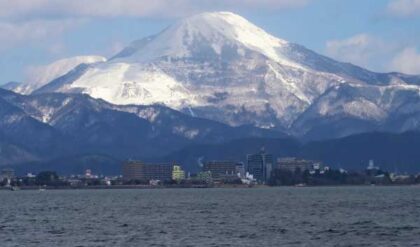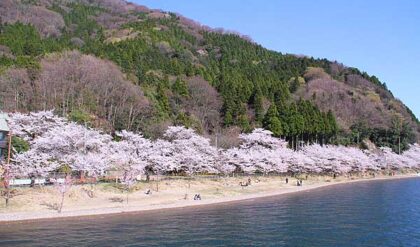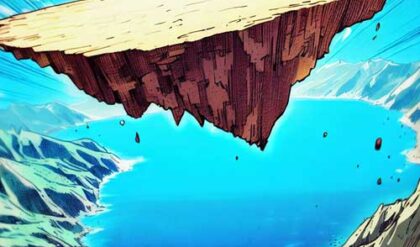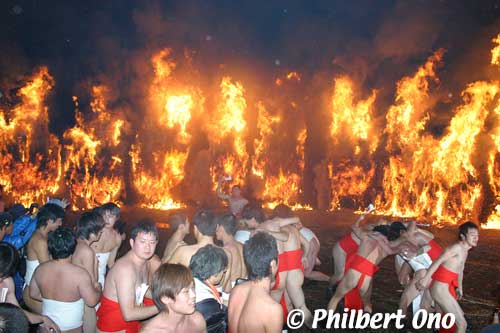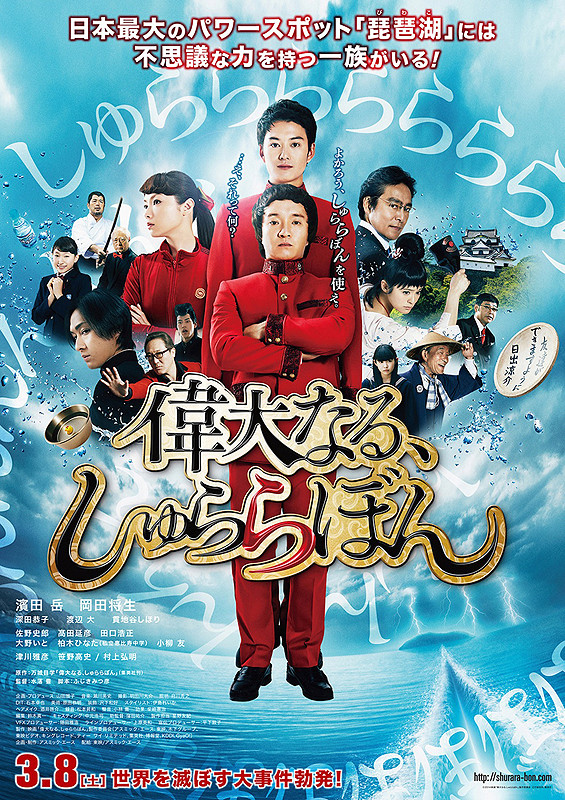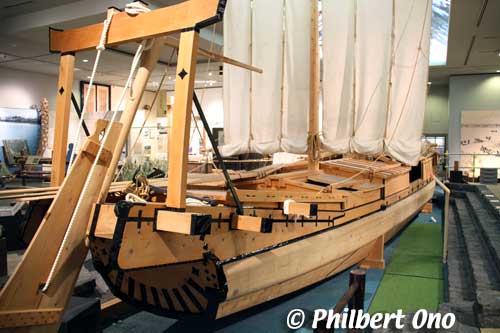Comprehensive guide to cycling around Lake Biwa and Shiga Prefecture, Japan.
By Philbert Ono, updated: April 27, 2023
Bicycling around Lake Biwa has become so popular that there’s a buzzword for it: “Biwa-ichi” (ビワイチ). It’s short for Biwako isshu (びわ湖一周), meaning “going around Lake Biwa.” Technically, we can go around Lake Biwa (Biwako) by car, train, boat, or on foot, but “Biwa-ichi” (also spelled BIWAICHI) is mainly associated with cycling around Lake Biwa.
It normally takes three full days to cycle around Lake Biwa with some sightseeing included. The terrain is mostly flat and much of the cycling route hugs the scenic lakeshore. A good support system for cyclists is also in place with bicycle rentals, cycling route markers, and convenience stores, etc., along the way where cyclists can rest and get food or water. Lodging is also available in cities where cyclists would want to stay.
You can also cycle just partially around the lake for a day trip or two-day trip. The most scenic part is the northern and western lakeshore. If you have time, you can also cycle around the lake’s South Basin south of Biwako Ohashi Bridge in Otsu (see map below).
When planning your cycling trip or any trip in Japan, do not rely on AI chatbots like ChatGPT or Google Bard. They are known to include serious errors and flaws in travel itineraries. Any travel itinerary created by ChatGPT, etc., need to be carefully checked and corrected by an expert guide. Details here.
Biwa-ichi history
No one seems to know who coined “Biwa-ichi” and when it came to the fore, but a local cycling association official says that it was found on the Internet as early as 2001, and cycling around the lake became noticeably popular by the early 2010s.
Shiga Prefecture started gathering Biwa-ichi statistics from 2015 when they found 52,000 people cycled around the lake that year. By 2017, 95,000 people did it, 20,000 more than in 2016. In 2018, it was about 100,000 per year (that’s about 270 per day). Indeed, cyclists along the lake have now become part of Lake Biwa’s landscape. (Drive along the lakeshore or look at Google Map Street Views of the lake to see what I mean.)

Bicycling has joined rowing as another recognized form of traveling around Lake Biwa. Rowing is actually the first Biwako isshu tour to be recognized (established by college rowers in the late 19th century) as there were no earlier practice nor religious pilgrimage of going around Lake Biwa.
Although there are roads and railways going around the lake, it has never become a thing to go around the lake by train or car. Probably because it’s not that scenic with most of the railways and roads well away from the lake shore. You also have to transfer trains at least twice along the way. And by car, there’s no sense of accomplishment. “I drove completely around Biwako!” is not something to brag about.
But long-distance cycling is something to brag about. It’s much more accessible and doable than rowing, so it’s much more popular. Biwa-ichi has thus become the first mass-scale Biwako isshu touring activity around Lake Biwa.
Shiga has always had rental bicycles at train stations around the lake. But they were mainly for day trips within the immediate vicinity. Until the early 2000s, it seems few people thought about spending a few days to cycle around the lake.
I’m surprised that it took this long for it to catch on. Excuse me for bragging, but I did it long before it became popular, long before the word “Biwa-ichi” was coined. To me, it was an obvious thing to do. There was a lake and a road going around it. And I had a good bicycle.
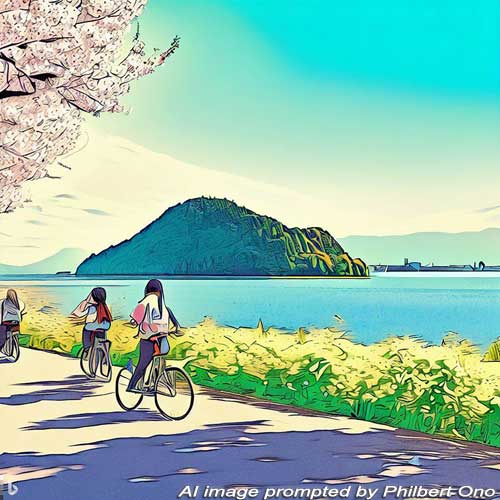
Long-distance cycling (bicycle touring) has long been a recognized outdoor activity, and Japan even set up a network of “cycling terminals” (サイクリングターミナル) in the 1970s where people and cyclists could lodge at low cost and rent bicycles. Even Nagahama had a cycling terminal (far from the train station), but it has since closed like many others in Japan due to a decline of guests. There are now only 14 cycling terminals in Japan (none in the Kansai/Kinki Region).
I was once an avid long-distance cyclist, and cycling completely around Lake Biwa in three days was one of my adventures. (This blog post includes photos of my Biwa-ichi trip.) Compared to my longer cycling trips like from Tokyo to Shiga in eight days or from Tsuruga (Fukui) to Izumo (Shimane) in nine days (with lots of sightseeing), cycling around Biwako was relatively quick and easy. (Perhaps earning my Cycling merit badge when I was a Boy Scout helped, lol.)
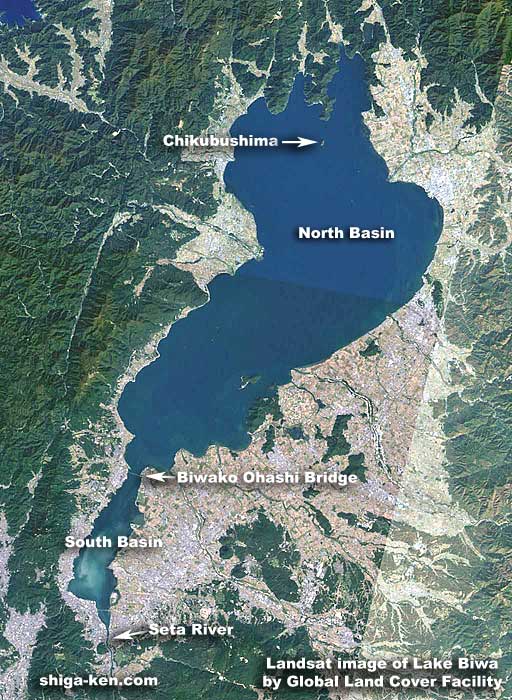
About the lakeshore road
Lake Biwa, Japan’s biggest lake, has a total shoreline (not road) of about 235 km (146 miles). The lake has the large North Basin and smaller South Basin divided by the 1.4-kilometer Biwako Ohashi Bridge spanning the narrow neck between the two.
The North Basin is more scenic and rural with less traffic (except during cherry blossom season). The North Basin’s lakeshore road is about 145 km (90 miles) long, while the South Basin’s lakeshore road totals about 45 km (28 miles). For long-distance cycling, it’s normal to pedal 60 to 80 km (about 40 to 50 miles) a day.
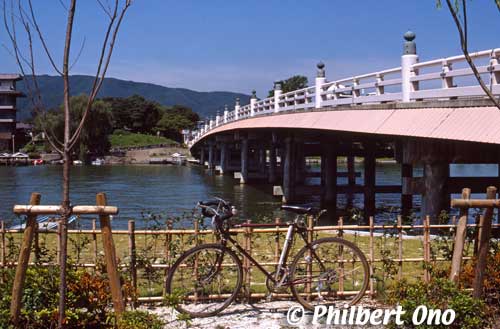
Lake Biwa has a lakeshore road (kogan-doro 湖岸道路) or bicycle/pedestrian path or sidewalk along most of the shoreline. The terrain is mostly flat except for the mountainous northern part. It takes the average person at least three days to cycle completely around Lake Biwa while mixing in a little (not a lot) sightseeing. This can be shortened to two days by taking a shortcut across the Biwako Ohashi Bridge (toll-free for cyclists and pedestrians) to skip the South Basin.
You can also take a cruise boat across the North Basin between Hikone or Nagahama Port and Imazu Port via Chikubushima island. If you take a shortcut, you won’t be able to boast that you actually cycled completely around the lake. I didn’t take any shortcuts and cycled completely around (including over the northern mountains) and crossed Seta-no-Karahashi Bridge on the southern end. If you have the time and energy, I recommend cycling around the South Basin as well.
It’s easy to follow the lakeside roads and cycling route. It looks straightforward on any road map. Just ride on the road or path closest to the shore. Note that some pedestrian/bicycle paths along the shore or beach (like near Omi-Maiko) might not be noticeable on a map or on Google Street Views. Just go there and find it.
The busiest road is Route 558 along Otsu’s western shore south of Biwako Ohashi. It can be hazardous for young riders, so be extra careful.
With the lake on one side and mountains on the other, it’s easy to get your bearings without getting lost (unless you wander into the interior without a map). Cycling markings on the road and noticeable landmarks also help. The city of Moriyama even has Shiga’s only bicycle police force called the “Moriyama Cycle Police.”
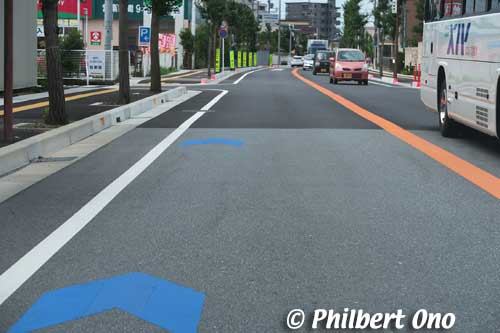
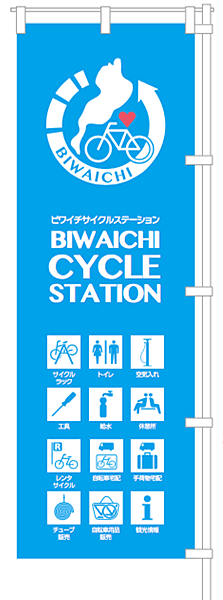
There are many scenic routes, scenic points, and tourist sights around the lake. You can enjoy beaches (soak your feet in the lake), lakeside parks, and bird-watching stations.
There are over 100 rivers and streams flowing into the lake so you will be crossing many rivers and streams, large and small. Seta River on the lake’s southern tip is the only river flowing out of the lake.
The fringe of Lake Biwa is also dotted with smaller bodies of water called “attached lakes” (naiko 内湖) which are small, natural bodies of water connected to Lake Biwa via a waterway. They are important for Lake Biwa’s ecosystem and wildlife.
Support for cyclists
Except for the most remote areas along the northern shore and mountains, you can easily find convenience stores, supermarkets (Heiwado and Friend Mart), shopping malls, and restaurants along the way.
Shiga has about 140 convenience stores, roadside stations (local farmer’s market and eatery), supermarkets, hotels/inns, and bicycle shops designated as “Biwaichi Cycle Stations” providing bicycle parking, tire pumps and tubes, bicycle tools, restrooms, bicycle shipping within Japan, and other things for cyclists. They are indicated by a blue banner (see image).
Cycling around Lake Biwa is now easier with smartphone cycling apps using GPS, online maps (including Google Map Street Views), road markings for cyclists, and Biwaichi Cycle Stations.
There is usually more than one road/path you can take to get to your destination. Along the east and west shores, the shortest route is usually the main road with heavy traffic. It is better to stick to the lakeshore as much as possible. There are three basic ways to go about cycling in Shiga:
a. Take two or three days to cycle around Lake Biwa.
b. Take a day trip or a few hours to cycle partially around Lake Biwa.
c. Take a side trip and cycle inland away from the lake.
All options can be very enjoyable. You will need to make some decisions for any cycling trip. This comprehensive article should help you decide what’s best for you, know what to expect, and know what to look out for in Shiga for your maximum safety and enjoyment. Cycling is great exercise, gives great views and photo ops, and it’s an unforgettable experience.
Shiga Prefecture Biwa-ichi Cycling FAQ
Q1: Where should I start cycling around Lake Biwa?
Q2: Where can I rent a bicycle in Shiga Prefecture?
Q3: How can I ship my bicycle to Shiga or within Japan?
Q4: Can I take a bicycle on trains in Japan and Shiga Prefecture?
Q5: When is a good time to cycle in Shiga?
Q6: Should I cycle clockwise or counterclockwise around Lake Biwa?
Q7: Where should I lodge while cycling around Lake Biwa?
Q8: What are the most scenic cycling routes around Lake Biwa?
Q9: What are the major sights around Lake Biwa?
Q10: How much sightseeing can I do while cycling around Lake Biwa?
Q11: Which parts around Lake Biwa are the most difficult to cycle?
Q12: Any recommended itineraries for cycling around Lake Biwa?
Q13: How do I find out about road closures in Shiga?
Q14: Is wearing a bicycle helmet required in Japan?
Q15: Can I cycle on pedestrian sidewalks in Japan?
Q16: What other cycling laws and rules are there in Japan and Shiga?
Q17: Where can I buy bicycle liability/accident insurance?
Q18: What if I get a flat tire?
Q19: Any other tips and advice for cycling in Shiga?
Q20: Biwa-ichi is a National Cycle Route. What does that mean?
Q21: Besides Biwa-ichi, what other recommended cycling routes are there in Shiga?
Q1: Where should I start cycling around Lake Biwa?
If you have your own bicycle, you can start anywhere that is most convenient for you. If you are visiting Shiga, starting from your arriving train station or hotel may be most convenient.
If you are coming from the west like Kyoto or Osaka, you can start from a train station in Otsu such as JR Otsukyo Station (JR Kosei Line), JR Otsu Station (Tokaido/Biwako Line), or Biwako Hama-Otsu Station (Keihan Line).
If you’re coming from the east such as Tokyo or Nagoya, start from JR Maibara Station (JR Tokaido Line). If you’re coming from the north like Fukui or Kanazawa, start from JR Omi-Shiotsu Station or JR Nagahama Station (JR Hokuriku/Biwako Line).
If you need to rent a bicycle in Shiga, start from where you rent the bicycle.
Q2: Where can I rent a bicycle in Shiga Prefecture?
There are many places where you can rent a bicycle in Shiga. Most are in or near a train station. Most rent out day-trip bicycles, but at least three vendors rent long-distance bicycles. See below. They will want a photocopy of your passport or photo ID. Major hotels in Shiga may also have rental bicycles for guests.
Also, if you rent a bicycle at one train station, you can usually return it at a different train station or location. Ask the vendor where you can return it. They may charge extra for the drop off. Be sure to remember the time when you must return the bicycle.
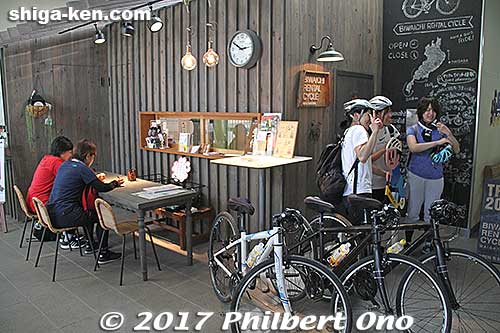
Long-distance bicycles for rent in Shiga:
- Biwako Isshu Rental Cycle (https://biwaichi-cycling.com/en/ びわこ一周レンタサイクル)
Conveniently located right inside Maibara Station near the East Exit. They have a good choice of high-end bicycles (including kids bicycles) and even a shower booth. Reserve a bicycle up to three months in advance with their online form or call 090-3863-8453. Open 9:00 am to 6:00 pm, closed on Wed. and from mid-Dec. to mid-Feb. when it’s too cold to bicycle. - Giant Store Biwako Moriyama (https://giant-store.jp/moriyama/ ジャイアントストアびわ湖守山)
In Moriyama near the Biwako Ohashi Bridge, this shop is on the 1st floor of the Lake Biwa Marriott Hotel along the lakeshore road. The Giant Store is a chain of bicycle shops in Japan affiliated with the Giant bicycle company in Taiwan. All their bicycles for rent or sale are from Giant. Since they also rent their latest models, you can test ride their bicycles. Reserve a bicycle with their online form (in Japanese only) or call the Moriyama branch at 077-584-2033. Open 9:00 am to 7:00 pm, closed on Tue. Note that this hotel is not near any train station. You need to take a bus or taxi from JR Katata or Moriyama Station. - Otsu Station Tourist Information Center (http://www.otsu-guide.jp/cycle_en.php オーツリー)
Conveniently located in the Otsu Station building. Reserve a bicycle via email. Cross bikes and electric bicycles available. Rent a bicycle up to 3 days. Open 9:00 am to 6:00 pm.
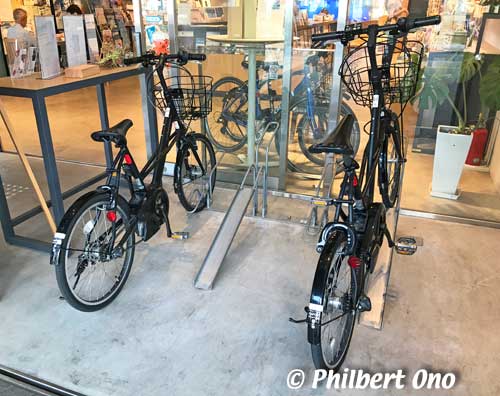
Day-trip bicycles for rent in Shiga:
For short cycling trips, you can rent an ordinary bicycle at the following train stations in Shiga for several hundred yen. Reservations are usually not necessary unless you’re renting as a large group. Note that most speak only Japanese.
Bicycle rental vendors may be inside or near the train station. The vendor is usually the local tourist bureau or a third-party vendor in front of the station. Note that you have to return the bicycle before the vendor closes. Be sure to remember the return time. Ask the train station staff where you can rent a bicycle: Renta saikuru wa doko desuka? (レンタサイクルは何処ですか?)
For example, in the case of Takashima city along the western lakeshore (JR Kosei Line), you can rent a bicycle at Shin-Asahi Station, Omi-Takashima Station, Adogawa Station, Omi-Imazu Station, or Makino Station and return the bicycle at another train station in the city. Rental hours at Omi-Takashima, Adogawa, and Omi-Imazu Stations are 9:00 a.m. to 1:00 p.m. Hours at Shin-Asahi and Makino Station are 9:00 a.m. to 5:00 p.m. (as of Nov. 2022). You can also rent a bicycle overnight. Rental rates are ¥500/day for a regular bicycle and ¥2000/day for e-bike (limited number). You can make reservations by phone (in Japanese): 0740-33-7101 More info in Japanese here: https://takashima-kanko.jp/guide/rentalcycle.html
JR train stations in Shiga: Aburahi Station, Adogawa Station, Azuchi Station (North exit), Hikone Station (Heiwado AL Plaza Megurinko), Ishibe Station, Kawake Station, Kibukawa Station, Kinomoto Station, Koka Station, Konan Station, Kosei Station, Kusatsu Station, Maibara Station (East exit), Makino Station, Moriyama Station, Nagahama Station (West exit), Nagahara Station, Notogawa Station, Omi-Hachiman Station, Omi-Imazu Station, Omi-Shiotsu Station, Omi-Takashima Station, Otsu Station (Tourist Information Center), Sakamoto Hiezan-guchi Station, Sakata Station, Samegai Station (Mizu-no-eki), Shigaraki Station, Shin-Asahi Station (West exit, Tabichari Center), Takatsuki Station, Terasho Station, Torahime Station, and Yogo Station.
Ohmi Railways Stations: Echigawa Station, Gokasho Station, Hikone Station (AL Plaza), Hino Station, Kibukawa Station, Maibara Station, Taga Taisha Station, and Yokaichi Station (Kokka Shop).
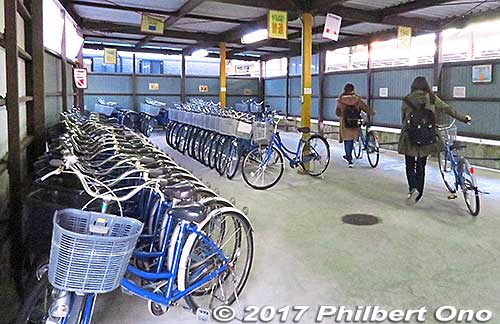
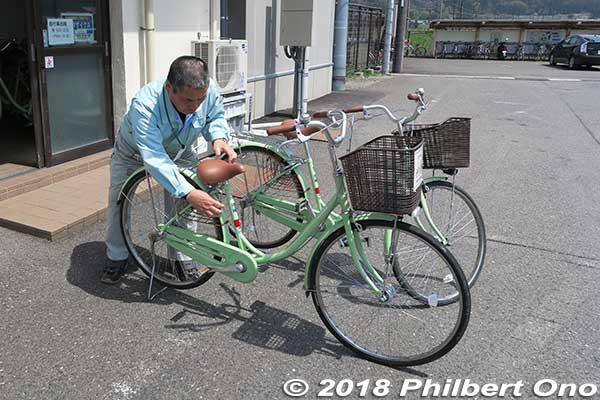
Q3: How can I ship my bicycle to Shiga or within Japan?
If you plan to stay at a hotel, etc., in Shiga the night before your cycling trip, you can use one of the following courier services to ship your bicycle to the hotel. You will need to pack your bicycle in a corrugated cardboard box that you can buy from the courier company. Your bicycle must be folding or have detachable wheels, etc., to make it compact for shipping. Shipping a bicycle to Shiga from within Japan will cost around ¥6,000 to ¥11,000 depending on your location. After your cycling trip, you can ship your bicycle from Shiga by going to a Biwaichi Cycle Station that offers bicycle shipping to within Japan.
- Yamato Transport – English information provided. https://faq-en.kuronekoyamato.co.jp/app/answers/detail/a_id/3084/c/531
- CycloExpress (http://cycloexpress.co.jp/) – Info in Japanese only.
- Seino Transportation (http://www.cycle-seino.jp/) – Info in Japanese only.
You can also carry your bicycle with you on the train to Shiga. See next question.
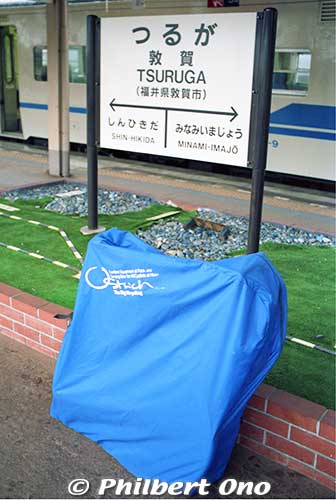
Q4: Can I take my bicycle on trains in Japan and Shiga Prefecture?
Yes, you can take a bicycle with you on JR trains in Japan and in Shiga (including the shinkansen*) for free. The bicycle must be packed in a bicycle bag (in folded state or compacted with front wheel detached, etc.). It must be completely contained in a genuine bicycle bag (rinko-bukuro 輪行袋), not a garbage bag, etc. The handlebars, seat, etc., cannot be sticking out of the bag.
Best to board the train’s first or last car (carriage) which is usually the least crowded. On the shinkansen or limited express (tokkyu) trains, store the bagged bicycle behind the last row of seats in the car or near the doors without obstructing passengers. Make sure it does not fall over. Avoid bringing a bicycle on a train during the rush hour in the morning (7:30 am–9 am) and late afternoon (5 pm–7 pm).
At most Ohmi Railways train stations on weekdays during 9:00 am to 4:00 pm and on weekends anytime, you can bring your bicycle on board as is, without packing it in a bag. It’s free. However, bicycles must be packed in a bag when boarding at the following Ohmi Railways train stations: Hikone, Minakuchi Ishibashi, Omi-Hachiman, Musa, Hirata, Ichinobe, Tarobogu-mae, and Shin-Yokaichi Stations.
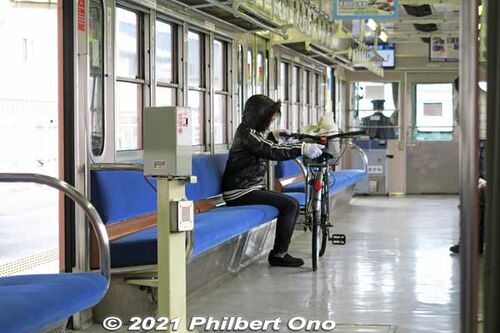
*From May 2020, reservations will be required to bring large-size luggage (total dimensions between 160 cm and 250 cm) on the Tokaido and Sanyo shinkansen. If you don’t have reservations for the luggage, they will charge ¥1,000. They are doing this for security purposes prior to the Tokyo Olympics.
Q5: When is a good time to cycle in Shiga?
Like the rest of Japan, the most pleasant and comfortable time is spring (April–May) and autumn (Oct. to mid-Dec.). In mid-April, cherry blossoms line the northern lakeshore. During winter (Dec.–March), snow in northern Lake Biwa will close certain roads and tunnels. Rental bicycles may also be unavailable. Avoid the rainy season from around mid-June to mid-July. From July to September, watch for rainstorms and typhoons. Note that rain is possible on any day of the year, so having a raincoat or Plan B is recommended.
Q6: Should I cycle clockwise or counterclockwise around Lake Biwa?
Either way is okay. The official recommendation is to cycle counterclockwise so you will be on the left side of the road nearer to the lake shore for a better view. (In Japan, they drive on the left side of the road.)
However, I did it in the clockwise direction and did not notice much difference since most of the cycling paths and roads were not that wide. If you want to go up the Oku-Biwako Parkway mountain road up north (if the road is not closed), you should ride around the lake clockwise. And since most people are cycling counterclockwise, it might be less crowded cycling clockwise. However, these days, you might face a lot oncoming bicycle traffic, so it might be best to ride counterclockwise around the lake.
Q7: Where should I lodge while cycling around Lake Biwa for two or more days?
Where you should stay overnight will depend on where you start your cycling trip, how far you want to cycle in one day, whether you will take the shortcut across Biwako Ohashi Bridge, and whether you will cycle clockwise or counterclockwise.
Shiga has a good number of lakeside hotels and inns convenient for cyclists. They are located in lakeside cities like Maibara, Moriyama, Otsu, Takashima, and Nagahama. Most of the ones I show on my Biwa-ichi Google Map offer reasonable rates. Room rates are usually cheaper if you make reservations directly with the hotel rather than through an agency.
*Be aware that Shiga also has gaudy-looking “love hotels” which are for couples seeking intimate privacy for a few hours. You can avoid those unless you cannot find anywhere else to stay.
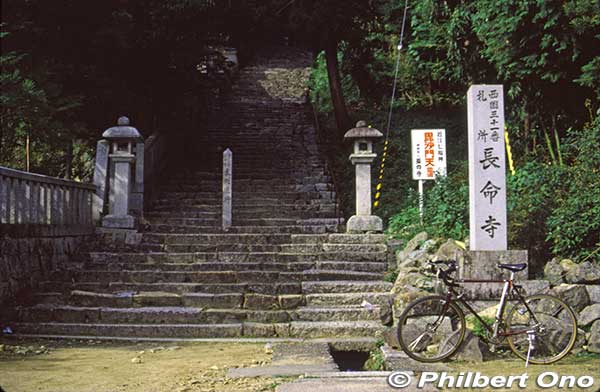


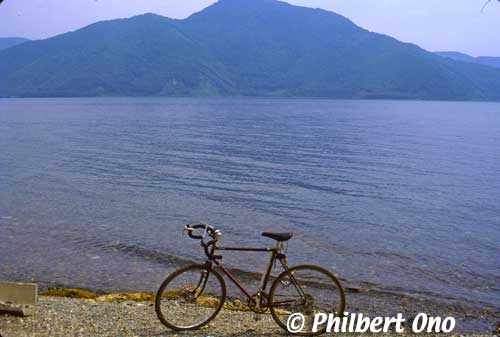
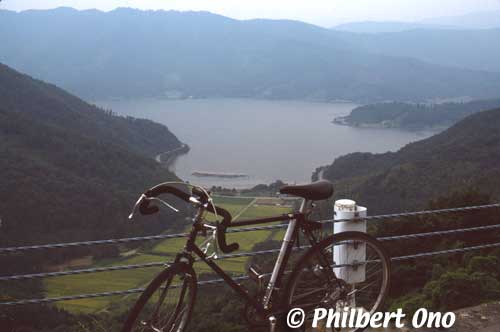
Q8: Where are the most scenic cycling routes around Lake Biwa?
Any section with lake views is scenic. They include white sand beaches and coastal roads on the western shore, the northern lakeshore road with views of Chikubushima island (and cherry blossoms in April), Oku-Biwako Parkway on the mountains (if it is open and you’re willing to climb up), and central Otsu’s waterfront. My Biwa-ichi Google Map shows a few of the scenic routes.
Q9: What are the major sights around Lake Biwa?
Major sights easy for cyclists to see (going clockwise) include Hikone Castle, Omi-Hachiman townscapes, Sagawa Art Museum, Lake Biwa Museum, Ishiyama-dera Temple, Miidera Temple, Biwako Otsu-kan, Karasaki Shrine, Ukimido Floating Temple, Omi-Maiko beach, Shirahige Shrine (torii in the lake), Harie, Imazu, Kaizu-Osaki, Maruko-bune Boat Museum, Sugaura Traditional Townscape, Oku-Biwako Parkway and Tsuzurao Ozaki Scenic Point, Kinomoto Giant Jizo Statue, Kohoku Wild Bird Center, Nagahama Castle, and Yanmar Museum.
You will likely not have enough time to see all of the above. So you will have to choose. There are also other side-trip sights like Azuchi Castle that are a little far from the cycling route. See more places of interest on my Biwa-ichi Google Map.
Q10: How much sightseeing can I do while cycling around Lake Biwa?
If you plan to cycle about 60 to 80 km in a day, you’ll probably have enough time to visit only one or two sights (castle, temple, museum, etc.) along the way. You also need to allow time for meals and breaks. You may not want to visit tourist sights in strenuous locations such as Chomeiji Temple with 800 steps up a mountain in Omi-Hachiman.
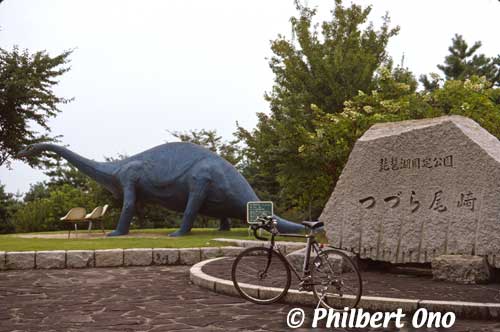
Q11: Which parts around Lake Biwa are the most difficult to cycle?
The mountainous northern part is the most strenuous (Oku-Biwako Parkway), but there is an alternate route going through Yanokuma tunnel. Oku-Biwako Parkway is a mountain road with a summit area and a few scenic points. However, most of the road might be closed due to a landslide or snow. See the road’s current status here: http://www.shiga-douro.jp/pc/
The section that is open goes only to the lookout summit called Tsuzura Ozaki. You can enter Oku-Biwako Parkway only from the south end at Sugaura, not from the north end. If you want to go up Oku-Biwako Parkway, you should ride around the lake clockwise. See my Biwa-ichi Google Map.
Also, western Otsu has busy city streets between JR Otsukyo Station and JR Horai Station (especially along Route 558) and you can hardly see the lake. If you are cycling with young kids, avoid this section. However, major attractions along this section includes the famous and scenic Katata Ukimido Floating Temple in the lake, Ogoto Onsen hot spring, Sakamoto (Castle and Hiyoshi Taisha), Karsasaki Shrine (pine tree), and Biwako Otsukan.
Things are quieter and more scenic northward from JR Horai Station.
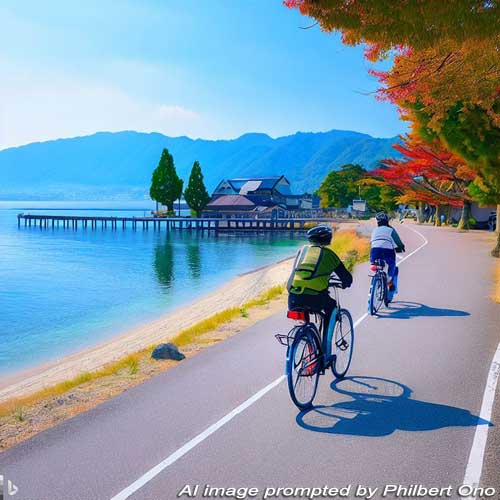
Q12: Any recommended itineraries for cycling around Lake Biwa?
Here are sample three-day clockwise and counterclockwise itineraries starting at Maibara and Otsu. On the first day, I prefer to cycle a shorter distance to allow my body to get into condition. Also see my Biwa-ichi Google Map while following the sample itineraries.
Three-day trip going COUNTERCLOCKWISE (both North and South Basins):
- Start at Maibara Station → Nagahama Castle → Yanokuma Tunnel → Oura (Optional: Sugaura and Oku-Biwako Parkway*) → Kaizu-Osaki → Lodge in Makino or Omi-Imazu → Shirahige Shrine → Omi-Maiko → Ukimido Temple → Lodge in central Otsu → Cross Seta-no-Karahashi Bridge → Miyagahama Beach → Hikone Castle → Maibara Station
- Start in Otsu→ Pier Moriyama mall → Miyagahama Beach → Hikone Castle → Lodge in Hikone or Maibara → Nagahama Castle → Yanokuma Tunnel → Oura (Optional: Sugaura and Oku-Biwako Parkway*) → Kaizu-Osaki → Lodge in Makino or Omi-Imazu → Shirahige Shrine → Omi-Maiko Beach → Ukimido Temple → Otsu
Three-day trip going CLOCKWISE (North and South Basins):
- Start at Maibara Station→ Hikone Castle → Lodge in Moriyama near Biwako Ohashi Bridge → Cross Seta-no-Karahashi Bridge (Otsu) → Ukimido Floating Temple → Shirahige Shrine → Lodge in Omi-Imazu → Kaizu-Osaki → Oura → (Optional: Sugaura and Oku-Biwako Parkway*) → Yanokuma Tunnel → Nagahama Castle → Maibara Station
- Start in Otsu → Ukimido Temple → Shirahige Shrine → Lodge in Omi-Imazu or Makino → Kaizu-Osaki → Oura → (Optional: Sugaura and Oku-Biwako Parkway*) → Yanokuma Tunnel → Nagahama Castle → Lodge in Maibara or Hikone → Hikone Castle → Cross Seta-no-Karahashi Bridge (Otsu)
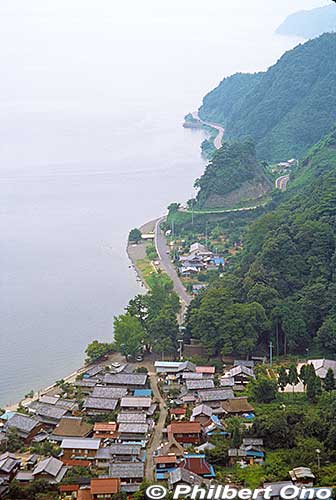
*Along the northern lakeshore, there’s a scenic lakeside road leading to the traditional townscape of Sugaura. If you have the time and energy, riding to Sugaura is very nice. Sugaura also has the entrance to the Oku-Biwako Parkway road that goes up the mountain. As of this writing, Oku-Biwako Parkway is open only up to the summit’s lookout point. You then have to ride back down the same way. It’s a pretty tough climb and might not be worth it. Sugaura is worth seeing, but it will be a side trek away from your main cycling route around the lake and you will have to backtrack afterward.
For shorter trips, you can start from Biwako Ohashi Bridge (from Moriyama if you’re coming from the east or from Katata if you’re coming from the west) and skip the South Basin (Otsu and Kusatsu). It’s also possible to ride a cruise boat between Hikone or Nagahama Port and Imazu or Makino Port via Chikubushima island. You may have to pack the bicycle in a bicycle bag and a baggage fee may be charged. (Cycling is not possible on Chikubushima.)
Cycling on weekdays will be less crowded than on weekends and national holidays. More hotel rooms and rental bicycles will also be available.
Q13: How do I find out about road closures in Shiga?
Closed roads are always possible due to repair work, snow, landslides, etc., (especially the northern mountains or Oku-Biwako Parkway). You can check the status of roads in Shiga here (red roads marked with a circled X mark are closed): http://www.shiga-douro.jp/pc/
Also see: https://biwaichi-cycling.com/information-roadclosedinwinter-en/
Q14: Is wearing a bicycle helmet required in Japan? (Updated)
Mostly yes, but it’s still not totally illegal to not wear a helmet. Bicycle riders age 12 and younger are required by law to wear a bicycle helmet in Japan. People who are older are now strongly recommended to wear a bicycle helmet. In Shiga, cyclists age 65 or older are required to wear a helmet.
On Dec. 20, 2022, Japan’s National Police Agency announced that from April 1, 2023, all bicycle riders, regardless of age, must “make efforts” (着用努力義務化) to wear a helmet. It cites head trauma as the leading cause of fatal cycling accidents. However, it will not be illegal to not wear a helmet while riding a bicycle. There is no penalty if you don’t wear a helmet.
Most adult commuters on bicycle and casual riders in Japan do not wear a helmet. It’s impractical for many short-distance bicycle riders to carry around a bicycle helmet at school, work, supermarket, etc.
For long-distance cycling, wearing a helmet is highly recommended. Bicycle rental shops usually have helmets you can rent. Keep in mind that most bicycle fatalities are caused by head injuries. Wearing a helmet will greatly reduce this statistic.
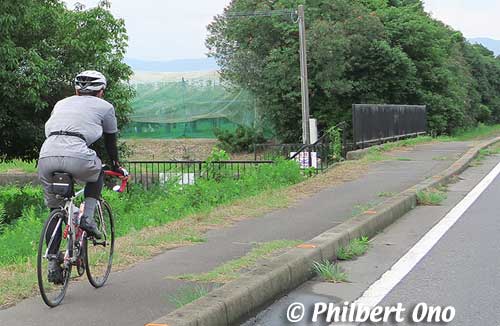
Q15: Can I cycle on pedestrian sidewalks in Japan?
In most cases yes, bicycles can legally go on sidewalks, but pedestrians have the right of way and you have to go slow. Many bike paths in Japan (sometimes painted red), especially along rivers and lakes, also see pedestrians. Be aware that in populated areas, riding on the sidewalk can be hazardous when a little kid or vehicle suddenly darts in front you from a driveway, door, etc. Disaster lurks everywhere, so you need to ride defensively.
Q16: What other cycling laws and rules are there in Japan and Shiga?
They include the following:
- Obey all traffic rules that apply to motor vehicles and bicycles. As with motor vehicles, ride on the left side of the road or bike lane or sidewalk.
- Be familiar with Japan’s road signs: https://en.wikipedia.org/wiki/Road_signs_in_Japan
- Your bicycle must have front and tail lights for use in tunnels, in the dark, etc.
- Since 2016, Shiga requires bicycle liability/accident insurance.
- Don’t look at your smartphone while riding. It’s illegal in Japan.
- Don’t use earbuds/headphones to listen to music while cycling. You need to hear what’s going on around you.
- Drinking (alcohol) and riding a bicycle is illegal in Japan.
- Holding an open umbrella while riding a bicycle is illegal.
- Park your bicycle in designated areas (churinjo 駐輪場).
Q17: Where can I buy bicycle liability/accident insurance?
Although it is not required nationally, bicycle liability insurance (jitensha hoken 自転車保険) is required in certain prefectures and Shiga is one of them along with Kyoto, Osaka, and Hyogo. If you hit a person while cycling and cause an injury (or worse), the victim can sue you. Due to recent Japanese court cases of cyclists being ordered to pay the victim a large sum of money, more prefectures are requiring or recommending bicycle insurance.
When you sign up for travel insurance in your home country, see if it covers bicycle accidents. If you will be renting a bicycle, inquire if the rental includes insurance. If you’re a Japan resident, you can sign up online with a bicycle liability insurance company. However, everything is in Japanese only. It costs a few thousand yen per year.
Here are a few bicycle insurance companies:
- Aeon: https://www.hokenmarket.net/member/jitensha.html
- Charipo: https://charipo.info/
- Seven-Eleven: https://ehokenstore.com/jitensya
- Sonpo Japan: https://www.shougaihoken.info/
More info for Shiga residents (in Japanese): http://shiga-hprtsa.jp/
Q18: What if I get a flat tire?
You’ll have to fix it yourself. Take a repair kit or spare tube with you and know how to repair a flat tire. Or if a train station is nearby, go there and see if you can return the rental bicycle there. Or call a taxi to pick you up.
Q19: Any other tips and advice for cycling in Shiga?
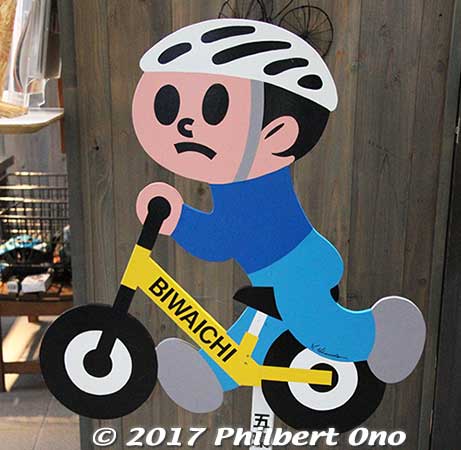
- For any accidents or emergencies, call 119 for an ambulance/fire, and 110 for police.
- Bicycle seats can be hard on your buns so you should wear cycling pants with a padded bottom. Gloves will help absorb vibration from the handlebars. Sunglasses protect your eyes from wind, flying bugs, and UV. Protect yourself from sunburn.
- Carry water and snacks, but travel as light as possible.
- When waiting at intersections or crosswalks, avoid standing too close to the edge of the road. Always watch out for passing motor vehicles. Careless or incapacitated drivers (heart attack, etc.) hitting pedestrians and cyclists are always possible.
- Even when the light turns green, always look both ways before crossing or proceeding. You never know when there’s a driver or cyclist running a red light, a careless driver, or worse (driver suffering a heart attack or blackout and losing control of the car). We sometimes hear on the news about pedestrians and cyclists on the roadside, sidewalk, or crosswalk getting hit by an errant car. In Shiga in 2020, over 100 accidents occurred at crosswalks. A few were fatal.
- Rain is possible on any day of the year. Sudden or unexpected showers can occur especially in summer. Check the weather before starting out and carry a raincoat. A bicycle with fenders will prevent water from the tires spraying on you.
- You may see wild monkeys on the roadside or roadside cliff. Do not approach or feed them. If you are carrying a plastic bag, they may try to grab it for food.
- Black kites (bird of prey) are common in Shiga. They are known to swoop down and snatch food from your hand or picnic spread. Beware of them when eating outdoors.
- Always lock your bicycle when parking it outside.
- Avoid cycling when it’s dark. Pace yourself so you will arrive at your destination before dark. Also be sure to turn on the bicycle light in tunnels.
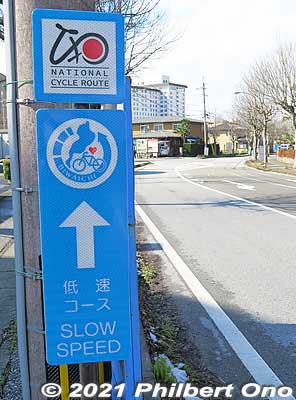
Q20: Biwa-ichi is a National Cycle Route. What does that mean?
It’s another tourism marketing ploy by the Japanese government’s Ministry of Land, Infrastructure, Transport and Tourism. Biwa-ichi is one of three cycling routes in Japan designated as a National Cycle Route (ナショナルサイクルルート) as of Nov. 2019.
(The other two routes are Lake Kasumigaura (Tsukuba-Kasumigaura Ring-Ring Road) Japan’s second largest lake in Ibaraki Prefecture and Shimanami Kaido crossing the Seto Inland Sea between Imabari, Ehime and Onomichi, Hiroshima.)
These routes have met the Ministry’s criteria for being well suited for cycling tourism with a scenic environment and good support and safety for cyclists. You might see National Cycle Route banners along the route. More info here: https://www.mlit.go.jp/road/bicycleuse/good-cycle-japan/national_cycle_route/english.html
Q21: Besides Biwa-ichi, what other recommended cycling routes are there in Shiga?
In the interior areas away from the lake, there are many cycling paths and scenic routes. Here are a few easy cycling routes for tourists. The locations are indicated on my Biwa-ichi Google Map under “Side trips.”
Lake Yogo (Nagahama) – Small, quiet, scenic lake in northern Nagahama that you can cycle or walk completely around. Cherry blossoms in April, hydrangea in June, and autumn flowers. Rental bicycles available at JR Yogo Station.
Azuchi Castle (Omi-Hachiman) – One of Japan’s most magnificent castles built by Oda Nobunaga was sadly destroyed three years after it was completed on a small hill. However, much of the stone work still remains. A life-size replica of the castle tower’s gorgeous top portion is exhibited in a nearby museum. Rental bicycles available near JR Azuchi Station.
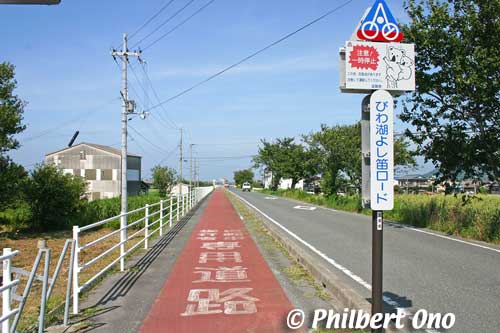
Notogawa Waterwheel and Canoe Land (Higashi-Omi) – Long, marshy park with cycling paths lead to a huge waterwheel, the symbol of Notogawa. Rental bicycles available near JR Notogawa Station.
Lake Nishinoko (Omi-Hachiman) – The largest attached lake famous for suigo boat rides through the reeds. This lake is lined with cycling paths. (On Google Maps, this lake is still mistakenly labeled in English as “Lake Sainoko.”) Rental bicycles available near JR Azuchi Station.
Seta River (Otsu) – A long outflowing river that goes all the way to Kyoto (where it becomes Uji River) and Osaka (where it becomes Yodo River). You can cycle along it as far as you wish. There are cherry blossoms along the riverside near Seta-no-Karahashi Bridge. Near JR Ishiyama Station and Ishiyama-dera Station.
Makino Metasequoia (dawn redwood) trees and Makino Highland (Takashima) – A short bike ride from Makino Station for this long, straight road lined with large metasequoia trees that turn color in autumn. If you have time, go further to Makino Highland, a recreational area for hiking, etc. Rental bicycles available at JR Makino Station.
Essential Vocabulary

Biwa-ichi (Biwaichi) – Cycling around Lake Biwa (ビワイチ)
bicycle – jitensha (自転車)
Lake Biwa – Biwako (琵琶湖)
cycling – saikuringu (サイクリング)
bicycle bag – rinko-bukuro (輪行袋)
bicycle accessories – jitensha yohin (自転車用品)
rental bicycle – renta saikuru (レンタサイクル)
flat tire – panku (パンク)
bicycle repair – jitensha no shuri (自転車の修理)
lake beach/shore – kogan (湖岸)
lakeside road – kogan-doro (湖岸道路)
traffic intersection – kosaten (交差点)
traffic signal light – shingo (信号)
bicycle parking – churinjo (駐輪場)
restroom – toire (トイレ)
convenience store – combini (コンビニ)
police (call 110) – keisatsu (警察)
ambulance (call 119) – kyu-kyusha (救急車)
accident – jiko (事故)
lake – mizu-umi (湖)
river – kawa (川)
bridge – hashi (橋)
attached lake – naiko (内湖)
bicycle insurance – jitensha hoken (自転車保険)
I’m exhausted. – Tsukareta. (疲れた)
Where can I rent a bicycle? – Renta saikuru wa doko desuka? (レンタサイクルは何処ですか?)
nori-sute (乗り捨て) – return bicycle at different location from rental location
Heiwado (平和堂) – Local supermarket chain.
michi-no-eki (道の駅) – roadside station (farmer’s market and restaurant)
charida (チャリダー) – Long-distance cyclist
mama-chari (ママチャリ) – Standard bicycle for mothers.
More Information
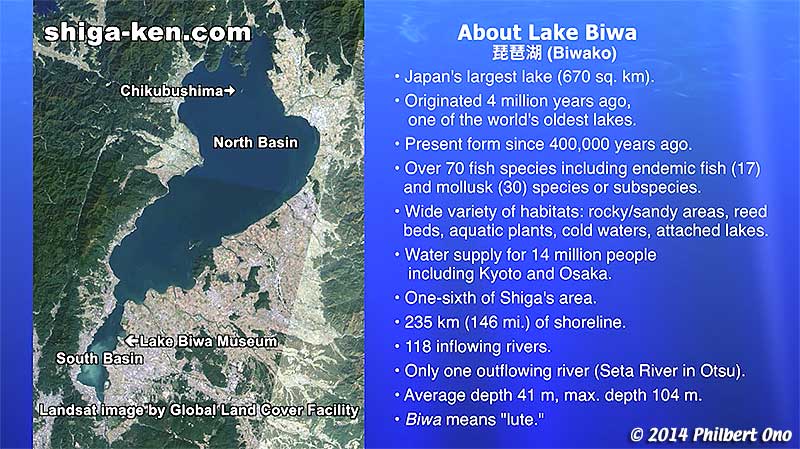
About Lake Biwa: https://photoguide.jp/txt/Lake_Biwa
Trivia
- “BIWAICHI” should be spelled “Biwa-ichi”. Official sources are spelling it “BIWAICHI”. It should be spelled “Biwa-ichi” because the word consists of two separate parts: “Biwa” and “ichi.” It’s not pronounced “Biwai-chi” for example. It also need not be in all capital letters. For some reason, many Japanese like to render ALL ENGLISH WORDS, TITLES, COMPANY NAMES, ETC., IN ALL CAPITAL LETTERS. One of the great mysteries of Japan…
- Awaji island in Hyogo Prefecture also has a cycling route around the island named “Awa-ichi.” By coincidence, Awaji island is shaped like Lake Biwa upside down.
- It is also noted that shape of Lake Biwa is similar to the country of Austria. Austrian tourism has started promoting Lake Biwa.
